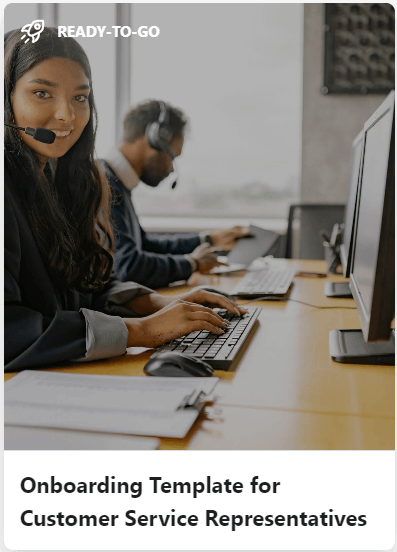Who do your customers interact most with? The answer is pretty obvious: your customer service team. Plenty of statistics highlight the important role those frequent service interactions play:
- 90% of Americans use customer service as a factor in deciding whether or not to do business with a company
- Nearly three out of five consumers say that good customer service is a crucial piece of their feelings of loyalty toward a brand
- 78% of customers say that they’ve backed out of a purchase as a result of poor customer service
There’s no denying it—customer service matters. But, how do you ensure that your team members are equipped to provide the top-notch attention that people demand? It all comes back to your customer service training program.
The best customer service training programs go beyond stiff manuals and seminars and empower employees to solve problems and delight customers. Wondering how to make that happen? We’re dishing out plenty of customer service training tips in this post.
Why is customer service training important?
You probably already know this, but customer service training can make or break your business. The most innovative business idea won't amount to much if your employees don't understand this simple principle. According to 123FormBuilder, 2023 customer service statistics indicate that 70% of the buying experience is based on how the customer is treated, and 90% of customers are willing to spend more when companies provide personalized customer services.
The above statistics probably clued you in on the biggest reason that customer service training matters: It improves how you show up in the market. When you provide personalized, high-quality, and prompt service to your customers, you can experience a huge array of other benefits like:
- More positive reputation: Customers talk about the service they receive. In fact, 36% of consumers say they’ll share their customer service experience with others, whether it’s good or bad. Word-of-mouth marketing is powerful, and you want your customers raving about their interactions with your business.
- Increased customer loyalty and retention: When customers have a great experience with your brand, they’re far more likely to come back. 89% of consumers say they’re more likely to make another purchase after a positive customer service experience.
- Higher sales: Combine your thriving reputation and loyal customers, and you get increased sales. Businesses can grow their revenue between 4% and 8% above their market if they make customer service experiences a priority.
Your customers and your bottom line both benefit from thoughtful customer service training programs. But, there’s another winner too: your customer service team.
Customer service is a stressful and oftentimes high-pressure role, which means burnout is prevalent among these teams. When you provide helpful, adequate training, you arm employees with the knowledge and resources they need to manage those sensitive situations—without burning themselves out.
By proactively managing team burnout through your training programs, you can reap a number of other benefits like increased employee engagement, reduced absenteeism, and boosted retention.
You also show your employees that you’re committed to giving them what they need to excel in their positions and careers. When 86% of employees say job training is important to them, your investment in their development and learning won’t go unnoticed.
Who should participate in customer service training?
When you think of customer service training, it’s easy to think about a single seminar or training session where employees get all of the information they need for an extended period of time.
However, keep in mind that customer service training doesn’t need to be something that happens once. You can offer it in a variety of situations, such as:
- When you bring on a new customer service hire
- When you need to refresh the team on best practices
- When a specific customer service incident happens
- When one of your tools or processes changes
Customer service training isn’t a one-and-done sort of thing. But, there’s another big question you need to answer: Who should be attending your training? Who should you be offering customer service tips to?
Your customer service team seems like the obvious answer—and it’s true, they’re the ones who should receive the bulk of your training.
However, it’s worth extending your training programs beyond that immediate, frontline team. “Customer service is not a department,” writes customer service expert, Shep Hyken, in an article for Forbes. “It is a philosophy to be embraced by every employee—from the CEO to the most recently hired.”
It’s worth looping other teams, managers, and employees in on some of your customer service training programs. While they won’t need to know the ins and outs of specific processes or pieces of software, it’s smart for them to be updated about best practices.
This not only helps them embrace an overall culture of high-quality customer service, but it also equips them with the right customer service mindset. If they ever need to cover a customer service duty for a team member or unexpectedly interact with a customer in another way, they at least have the base-level knowledge they need to handle that situation well.
Where to begin?
Now that we've established the why and the who, we need to start thinking about the how. How does one even begin to deploy a customer service training program? What are your options? Well, there are a number of methods, to be sure.
Option 1
One is the traditional method of using an in-person instructor in a classroom setting to go over the do's and don'ts of customer interaction. And while this method does have the advantage of the human touch, it gets tricky to manage schedules and can be costly if your team is remote or if you hire frequently.

Option 2
The second option is to use an online customer service course, which can be assigned to employees on-demand. This is a popular and cost-effective method, as there is no shortage of elearning soft skills courses. For example, the GoSkills course library offers a CPD-accredited customer service training course by renowned business coach and consultant David Brownlee.
Option 3
A third option is to customize your own course from a training template, such as those found in the GoSkills course builder template gallery. This option is a favorite because it comes content-ready, with the option to customize as much as you want with images, videos, quizzes, and more. This means you can go from zero to hero in record time. It's the perfect way to make your training as unique as your team is.
Customer service training tips to engage your team (and level up your customer satisfaction)
You’re equipped with the basics of customer service training programs—like why you need to prioritize them and who should be involved. Now let’s dig into the nitty-gritty of how you can take this training to the next level (without boring your employees).
1. Play with timing and formats
Think you can dump a customer service training manual on your employees and watch as they excel? Think again. As we mentioned above, high-quality customer service is something that should be emphasized and supported on a continuous basis.
Aim to provide some sort of customer service training at least every six months. That won’t feel like overkill to your employees, but it will also give you a chance to cover any current trends or developments.
It’s also smart to play with different training formats. There are no shortage of options like:
- Online courses
- Simulations
- Videos
- Seminars
- Hands-on tutorials
Some might work better for your content than others, but don’t be afraid to mix up your delivery method to ensure the customer service tips are as helpful and engaging as possible.
2. Keep an eye out for teachable moments
Not all of your training needs to be rigid, formal, and scheduled. There are likely plenty of scenarios that happen each day that provide a learning opportunity for you and your employees.
For example, maybe one of your customer service representatives needs to answer a customer question that hasn’t come up before. You don’t want that interaction to stay siloed with that single team member—it should be shared with everybody, so that the entire team can learn from how that played out.
To make this more manageable and scalable, create some sort of centralized place (like a Slack channel or a Google Doc) where you and your team can record information about interactions, questions, and more.
Having that detailed record gives both new and established employees a helpful resource they can turn to for training, outside of formal lessons and events.
3. Make your training accessible
Speaking of thinking outside of the box with your training opportunities, it’s helpful to provide self-paced training sessions for employees. They offer flexibility so that team members can learn at a time that’s most convenient for them, rather than tuning into a required seminar or training session when their inbox is full and their mind is elsewhere.
For that reason, 58% of employees say they prefer training opportunities that allow them to learn at their own pace. And, making this happen doesn’t need to be difficult. Look for a learning management system (LMS) that will help you offer self-paced online courses to your employees.
An LMS like GoSkills not only makes it easy to create your own courses, but you can also assign them to various team members and track their progress—so you know they’re actually completing the necessary lessons. Plus, GoSkills already has a customer service course to lay the right foundation for your employees.

4. Emphasize the importance of soft skills
Your customer service training materials and program will need to include information about your tools, processes, company procedures, and more.
But, don’t make the mistake of becoming so focused on technical elements and product knowledge that you forget about one of the most important elements of customer service: soft skills.
Soft skills are characteristics that are tougher to measure, but make a huge difference in our interactions. Need proof? 70% of the customer’s journey is based on how the customer feels they’re being treated by your organization.
That means your employees need to be equipped with the right soft skills to help those relationships and interactions go smoothly, and that might require some training. What soft skills should you be focusing on for your customer service team? A few important ones include:
- Attention to detail
- Communication
- Conflict resolution
- Emotional intelligence
- Patience
- Problem solving
When you’re ready to get started educating your team members about the power of soft skills, GoSkills has a number of relevant courses available.
5. Ask your team for feedback
Still stuck on how you can improve your customer training programs? Ask your employees for their feedback.
What do they think is missing from your current training offerings? What do they think is working really well? What situations or conversations did they feel ill-equipped to handle? What templates or resources do they wish they had access to?
Four out of five employees have ideas to improve the business they work for, but one in three feel their ideas are ignored. Giving them an opportunity to share their opinions and suggestions candidly will give you some valuable insight you can use to improve your training programs—or even offer completely new ones. The GoSkills course builder has an optional learner feedback form that's fully customizable for exactly this reason.
Customer service (training) matters
Customer service is important. That means that your customer service training carries just as much—if not more—weight.
Keep in mind that effective and engaging customer service training isn’t something that happens once. It should be offered on a consistent basis to cover a variety of topics in an array of formats.
One of the easiest ways to keep your training fresh is to use an online learning platform to offer self-paced courses. Your employees can get the information they need without training feeling like yet another obligation on their lengthy to-do lists.
When you prioritize your training programs and deliver them in a way that resonates with your employees, you’re far more likely to reap the benefits of one of the most important aspects of your company: your customer service.
Ready to deliver training programs to your employees in a way that’s accessible, streamlined, and even fun?
Keep your customers coming back!
Learn essential and practical customer service principles in this award-winning course.
Try it for free





